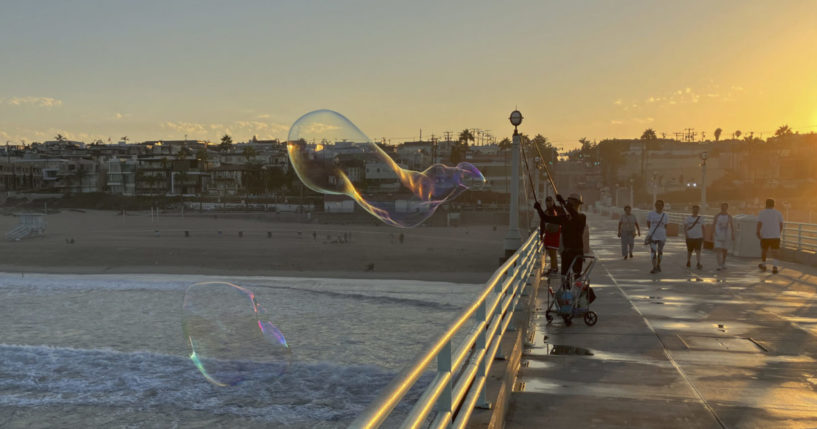
Weeks After Issuing Electric Car Mandate, Cali Faces Potential 'Stage 3 Energy Emergency,' Rolling Blackouts During Heat Wave
California is facing its highest chance of blackouts this year as a brutal heat wave continues to blanket the state with triple-digit temperatures.
State energy officials said the electrical load Tuesday afternoon could top 51,000 megawatts, the highest demand the state has ever seen.
As people crank up their air conditioners, the state forecasted record levels of energy use, said Elliot Mainzer, president of California Independent System Operators, which runs the state’s electrical grid.
The state has additional energy capacity at the moment “but blackouts, rolling, rotating outages are a possibility,” Mainzer said, calling additional conservation “absolutely essential.”
The CAISO site Tuesday morning showed California could fall more than 5,000 megawatts short of its power supply at peak demand, forecasted for 5:30 pm.
The danger of wildfires was extreme as scorching heat and low humidity turned brush to tinder. Four deaths were reported over the Labor Day weekend as some 4,400 firefighters battled 14 large fires around the state, with 45 new blazes on Sunday alone, said Anale Burlew, a deputy chief with the California Department of Forestry and Fire Protection.
In Southern California, two people were killed and one injured by the Fairview Fire, which started Monday near the city of Hemet, the Riverside County Fire Department said. Roughly 50 miles southeast of Los Angeles, the fire had quickly spread to more than 2,000 acres by 11 p.m., prompting evacuations, and was only 5 percent contained. Multiple residential structures burned.
California’s energy grid runs on a mix of mostly solar and natural gas during the day, along with some imports of power from other states. But solar power begins to fall off during the late afternoon and into the evening, which is the hottest time of day in some parts of the state. And some of the aging natural gas plants California relies on for backup power aren’t as reliable in hot weather.
At CAISO’s request on Monday, four temporary emergency power generators deployed by the Department of Water Resources in Roseville and Yuba City were activated for the first time since they were installed last year, providing up to 120 megawatts, enough electricity for 120,000 homes.
CAISO also has issued a Flex Alert call for voluntary conservation between 4 p.m. to 10 p.m. Tuesday, making seven alerts in as many days.
Consumers were urged to keep air conditioners at 78 degrees or higher during the period and avoiding using major appliances such as ovens and dishwashers.
The efforts have worked to keep the lights on “but we have now entered the most intense phase of this heat wave” that could last into the week, and two to three times the level of conservation will be needed from people and businesses, Mainzer said.
CAISO also issued a Stage 2 Energy Emergency Alert from 6:30 p.m. to 8 p.m. Monday. The second of three emergency alert stages means taking emergency energy-saving measures “such as tapping backup generators, buying more power from other states and using so-called demand response programs,” according to a CAISO website.
Stage 3 would be rolling blackouts.
Several hundred thousand Californians lost power in rolling blackouts in August 2020 amid hot weather, but the state avoided a similar scenario last summer.
Gov. Gavin Newsom signed legislation Friday that could allow the state’s last remaining nuclear plant to stay open beyond its planned 2025 closure, to ensure more power.
The National Weather Service predicted highs between 100 and 115 degrees across inland California, with 80s to 90s closer to the coast.
Nighttime won’t bring much relief, with many places seeing lows in the 80s or even 90s.
Ironically, unsettled weather also brought the chance of thunderstorms over Southern California and into the Sierra Nevada, with a few isolated areas of rain but nothing widespread. The storms also could produce lightning, forecasters said, which can spark wildfires.
South of the Oregon state line, the Mill Fire was 55 percent contained Tuesday morning after killing two people, injuring others and destroying at least 88 homes and other buildings since it erupted last week, CalFire said.
The bodies of the two women, 66 and 73, were found in the city of Weed on Friday, the Siskyou County Sheriff’s Office announced Monday. Details weren’t immediately released.
A few miles away, the Mountain Fire grew to nearly 18 square miles and only 20 percent contained, with winds threatening to renew its eastward spread in steep terrain, fire officials said.
The Western Journal has reviewed this Associated Press story and may have altered it prior to publication to ensure that it meets our editorial standards.
Truth and Accuracy
We are committed to truth and accuracy in all of our journalism. Read our editorial standards.
Advertise with The Western Journal and reach millions of highly engaged readers, while supporting our work. Advertise Today.











